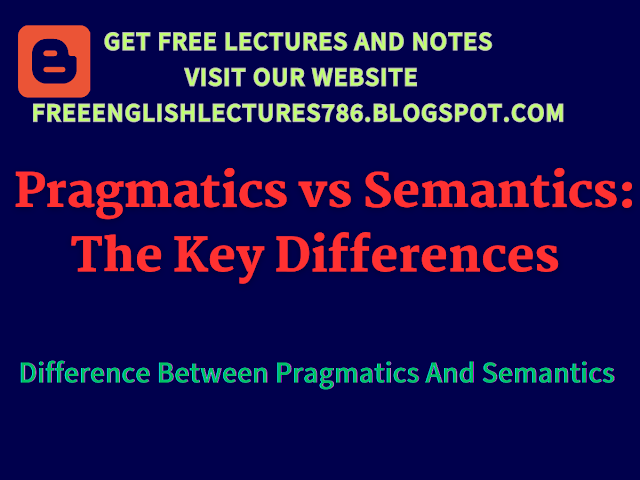Difference Between Pragmatics And Semantics
When studying language and communication, two terms that are often used are pragmatics and semantics. While they are both important concepts in understanding language, they have distinct differences. In this article, we will explore the differences between pragmatics and semantics, and how they affect communication.
Introduction
Language is a complex system that allows humans to communicate thoughts, ideas, and emotions. In order to fully understand language, it is important to study the underlying components that make it possible. Two of these components are pragmatics and semantics. Pragmatics refers to the study of how context affects meaning in communication, while semantics refers to the study of meaning in language.
What is Pragmatics?
Pragmatics is concerned with how context affects meaning in communication. It examines the way that language is used in specific situations to convey meaning. Pragmatics takes into account factors such as the speaker's intentions, the listener's interpretation, and the social context in which communication is taking place.
Speech Acts
One of the main areas of study in pragmatics is speech acts. A speech act is an utterance that is used to perform a specific action, such as making a request or giving a command. In order to understand the meaning of a speech act, it is important to consider the context in which it is used.
Politeness
Another important aspect of pragmatics is politeness. Politeness refers to the use of language to show respect, deference, or consideration for others. Politeness can vary greatly between cultures and can be influenced by factors such as social status and power.
What is Semantics?
Semantics is concerned with the study of meaning in language. It examines how words and phrases are used to convey meaning, and how different words can have different meanings depending on the context in which they are used.
Meaning
Studying meaning in language is the focus of semantics. Semantics examines how meaning is conveyed through language, and how different words can have different meanings depending on the context in which they are used. For instance, the term "bank" can be used to describe both a financial organization and the river's margin.
Reference
Another important aspect of semantics is reference. Reference refers to the way in which language is used to refer to objects, people, or concepts. Semantics examines how different words are used to refer to the same thing, and how the meaning of a word can change depending on the context in which it is used.
Differences between Pragmatics and Semantics
While pragmatics and semantics are both concerned with language and meaning, they have distinct differences. The main difference between pragmatics and semantics is that pragmatics is concerned with how context affects meaning in communication, while semantics is concerned with the study of meaning in language.
Context
Pragmatics takes into account the context in which communication is taking place, including the speaker's intentions, the listener's interpretation, and the social context. Semantics, on the other hand, focuses on the meaning of words and phrases, regardless of the context in which they are used.
Meaning
Semantics is concerned with the study of meaning in language, including how words and phrases are used to convey meaning. Pragmatics, on the other hand, is concerned with how context affects meaning in communication.
Speech Acts
Pragmatics is concerned with the study of speech acts, which are utterances that are used to perform specific actions. Semantics does not focus on speech acts, but rather on the meaning of words and phrases.
Conclusion
In conclusion, pragmatics and semantics are both important components of language and communication. While they are related, they have distinct differences. Pragmatics is concerned with how context affects meaning in communication, and takes into account factors such as the speaker's intentions, the listener's interpretation, and the social context. Semantics, on the other hand, is concerned with the study of meaning in language, including how words and phrases are used to convey meaning, and how different words can have different meanings depending on the context in which they are used.
Understanding the differences between pragmatics and semantics is important for effective communication. By taking into account both the context and the meaning of language, we can communicate more clearly and avoid misunderstandings.
FAQs
1. What is the difference between pragmatics and semantics?
The main difference between pragmatics and semantics is that pragmatics is concerned with how context affects meaning in communication, while semantics is concerned with the study of meaning in language.
2. Why is understanding pragmatics and semantics important for effective communication?
Understanding the differences between pragmatics and semantics is important for effective communication because it allows us to take into account both the context and the meaning of language, which can help us communicate more clearly and avoid misunderstandings.
3. What are some areas of study in pragmatics?
Some areas of study in pragmatics include speech acts, politeness, and the use of language in specific social contexts.
4. What are some areas of study in semantics?
Some areas of study in semantics include meaning, reference, and how different words can have different meanings depending on the context in which they are used.
5. Can pragmatics and semantics overlap?
Yes, pragmatics and semantics can overlap, as both are concerned with language and meaning. However, they have distinct differences in their focus and areas of study.
Free English Lectures
(Prepared by Sir Arshad)






0 Comments